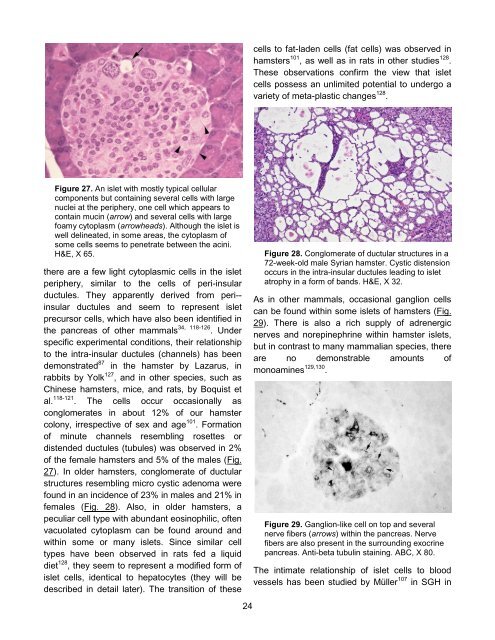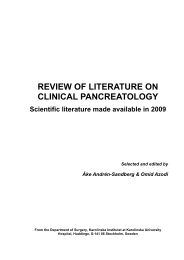Download PDF - The Pancreapedia
Download PDF - The Pancreapedia
Download PDF - The Pancreapedia
You also want an ePaper? Increase the reach of your titles
YUMPU automatically turns print PDFs into web optimized ePapers that Google loves.
Figure 27. An islet with mostly typical cellular<br />
components but containing several cells with large<br />
nuclei at the periphery, one cell which appears to<br />
contain mucin (arrow) and several cells with large<br />
foamy cytoplasm (arrowheads). Although the islet is<br />
well delineated, in some areas, the cytoplasm of<br />
some cells seems to penetrate between the acini.<br />
H&E, X 65.<br />
there are a few light cytoplasmic cells in the islet<br />
periphery, similar to the cells of peri-insular<br />
ductules. <strong>The</strong>y apparently derived from peri-insular<br />
ductules and seem to represent islet<br />
precursor cells, which have also been identified in<br />
the pancreas of other mammals 34, 118-126 . Under<br />
specific experimental conditions, their relationship<br />
to the intra-insular ductules (channels) has been<br />
demonstrated 87 in the hamster by Lazarus, in<br />
rabbits by Yolk 127 , and in other species, such as<br />
Chinese hamsters, mice, and rats, by Boquist et<br />
al. 118-121 . <strong>The</strong> cells occur occasionally as<br />
conglomerates in about 12% of our hamster<br />
colony, irrespective of sex and age 101 . Formation<br />
of minute channels resembling rosettes or<br />
distended ductules (tubules) was observed in 2%<br />
of the female hamsters and 5% of the males (Fig.<br />
27). In older hamsters, conglomerate of ductular<br />
structures resembling micro cystic adenoma were<br />
found in an incidence of 23% in males and 21% in<br />
females (Fig. 28). Also, in older hamsters, a<br />
peculiar cell type with abundant eosinophilic, often<br />
vacuolated cytoplasm can be found around and<br />
within some or many islets. Since similar cell<br />
types have been observed in rats fed a liquid<br />
diet 128 , they seem to represent a modified form of<br />
islet cells, identical to hepatocytes (they will be<br />
described in detail later). <strong>The</strong> transition of these<br />
24<br />
cells to fat-laden cells (fat cells) was observed in<br />
hamsters 101 , as well as in rats in other studies 128 .<br />
<strong>The</strong>se observations confirm the view that islet<br />
cells possess an unlimited potential to undergo a<br />
variety of meta-plastic changes 128 .<br />
Figure 28. Conglomerate of ductular structures in a<br />
72-week-old male Syrian hamster. Cystic distension<br />
occurs in the intra-insular ductules leading to islet<br />
atrophy in a form of bands. H&E, X 32.<br />
As in other mammals, occasional ganglion cells<br />
can be found within some islets of hamsters (Fig.<br />
29). <strong>The</strong>re is also a rich supply of adrenergic<br />
nerves and norepinephrine within hamster islets,<br />
but in contrast to many mammalian species, there<br />
are no demonstrable amounts of<br />
monoamines 129,130 .<br />
Figure 29. Ganglion-like cell on top and several<br />
nerve fibers (arrows) within the pancreas. Nerve<br />
fibers are also present in the surrounding exocrine<br />
pancreas. Anti-beta tubulin staining. ABC, X 80.<br />
<strong>The</strong> intimate relationship of islet cells to blood<br />
vessels has been studied by Müller 107 in SGH in












